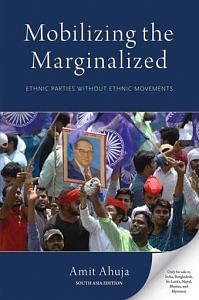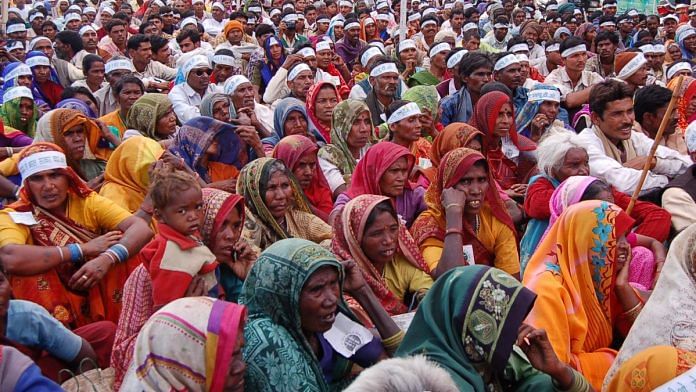In the 2004 Indian National Election Study, voters were presented with the following proposition: “It is important to vote the same way as members of one’s caste or community.” In Tamil Nadu and Maharashtra, 38% of Dalits agreed with the proposition, whereas in Uttar Pradesh and Bihar, 54% agreed with it. The same proposition had been put to Dalit respondents in the 1971 Indian National Election Study. At that time, 40.51% of Dalits in movement states and 59.5% of Dalits in the non-movement states agreed with it.
A linear regression of 827 Dalits’ attitudes toward voting with caste members across Tamil Nadu and Maharashtra as well as across Uttar Pradesh and Bihar (Table 5.23) shows that when other variables (education, age, location, socioeconomic status, and gender) of voters are controlled for, the variable called state type (referring to movement versus non-movement states) is statistically significant. The Dalit respondent’s attitude towards caste-based voting is the dependent variable. The location of the Dalit respondent, in a movement or a non-movement state, is the key independent variable. The finding suggests a distinct difference between movement and non-movement states with respect to attitudes toward bloc voting.
Dalits in Uttar Pradesh and Bihar were more likely to agree with the proposition of voting with caste members than were Dalits in Tamil Nadu and Maharashtra. Testimonies of focus group participants and interview subjects reflected this difference. In Tamil Nadu, during a focus group discussion, Dalits pointed out that caste discrimination was only one of the many challenges they faced. Often it was common needs in their area, and not caste, that motivated their support for political parties. One participant said, “Our community is treated badly, but there are other problems, too. We face the same difficulties as other castes living in our area.” In addition, voters did not identify parties with particular castes. As one voter in Maharashtra put it, “If a party will look into the welfare of the poor, then why should we look at caste?”
Also read: The Mayawati era is over. Bye Bye Behenji
In Uttar Pradesh and Bihar, the testimonies were qualitatively different. The focus group discussions shed light on how Dalits viewed collective voting. “During the elections, the samaj [the Dalit community in the locality] decides, and then most follow the samaj,” explained one participant. The same sentiment was echoed in another discussion: “Most people in the village vote their caste. Our community does the same.” When asked whether it was important to vote with members of one’s caste community, a discussion participant in Bihar asked, “Who else will one vote with?” “Elections are about caste. Like everyone I will vote with my caste members,” said one participant in a focus group in Uttar Pradesh.
When Dalits discussed their interest in bloc voting, they were rarely motivated by the caste of the candidate. For the most part, they were drawn to the party or its leadership. Dalits also interpreted their caste identity as their subcaste identity. So for example, when Jatavs in Uttar Pradesh said that it was important for them to vote with their fellow caste members, they meant fellow Jatavs, and not other Dalit subcastes. The same was true for Dusadhs in Bihar, Adi-Dravidas or Paraiyars in Tamil Nadu, and Mahars in Maharashtra.
The difference in attitudes toward bloc voting is not a reflection of ethnic parties’ success in some states and their relative failure in others. It predates the 1990s fragmentation of the party system and the rise of ethnic parties. The Indian National Election Study data help us trace the variation as far back as 1971. Further, a strong preference for bloc voting is also expressed in Madhya Pradesh and Rajasthan, two states where fragmentation of the party system has not occurred and where the success of Dalit ethnic parties has been limited, which suggests that caste-based bloc voting attitudes exist independent of ethnic party success.
Dalits in movement states do not vote in blocs, and instead divide their votes among different parties. Dalit support for political parties has continued to fragment along with the fragmentation of the party system since the 1990s. Voter testimonies in Tamil Nadu and Maharashtra point out that this fragmentation of support extends to the locality level; of 203 Dalit interview subjects, 47.2% said that members of their community in the locality supported different parties, and 23.6% of the subjects reported that members of their community in the locality voted for the same party.
When asked which parties had a stronghold in the locality, a focus group participant in Tamil Nadu said, “It is like the films. People like different stars. Similarly, people like different parties in our locality.” During an interview, a subject explained how support for party choice had shifted among the new generation in her locality. She said, “The older generation in our locality supports the AIDMK and sometimes the DMK, but young people support the DMDK or the VCK.” The testimonies in Maharashtra pointed to a similar outcome. A teacher in the village school said during the interview, “It is difficult to tell how people in our locality vote. In our community, there are supporters and activists of different parties. In this village alone, there is a group that supports the RPI and another that votes for the Congress Party.” In a focus group in an urban Dalit locality, a participant said, “In my house, my wife and I support different parties. She voted for the NCP and I voted for the BSP. No one party has a hold on our community.” Andre Beteille reminds us, “To the extent that a caste does not identify itself persistently with any particular party but tends to divide and subdivide and to enter into multifarious alliances across its boundaries, its very contours ultimately become blurred.”
Also read: Why neo-liberal capitalism failed Dalit enterprise
With Dalits less amenable to bloc voting, sometimes even at the locality level, elections in movement states are not zero sum competitions between caste groups. Dalits there are less likely to view political parties through the caste lens alone. Dalit voters were asked to name the factors that were important in their selection of parties. In Tamil Nadu and Maharashtra, in 40% of forty focus group discussions, and in 32% follow-up interviews with 203 subjects, caste was identified as one of the factors.
By contrast, the habit of banding together during elections has continued among Dalit voters in Uttar Pradesh and Bihar. This has made Dalit support more likely for a single party rather than for multiple parties. In one-on-one interviews, 22.3% of the Dalit subjects said that members of their community voted for different parties, and 55.8% of the subjects said that members of their community voted for the same party. Explaining his support for the Dalit party, an interview subject in Uttar Pradesh said, “Only someone who is from our group and understands our plight will care for us. Other parties will only care for their own.” Another subject said, “Earlier we voted for the Congress Party in this locality—men, women, old and young—everyone. Today, people vote for the BSP. Parties have changed [from the Congress to the BSP], but the community has voted together.” Bloc voting turns elections into an all-or-nothing contest for Dalit voters, and they view political parties predominantly through their caste interests. Dalits in 75% of forty discussions, and in 54% of the 206 interviews in Uttar Pradesh and Bihar identified caste as one of the factors in their selection of parties.
Lower interest in bloc voting in movement states suggests that these blocs were unavailable not only to ethnic, but also to multiethnic parties. Multiethnic parties in Tamil Nadu and Maharashtra, as a result, were incentivized to rely more on cross-group appeals than ethnic appeals to mobilize Dalits. By contrast, in non movement states stronger interest in bloc voting among Dalits incentivized even multiethnic parties to use ethnic appeals more than cross-group appeals to mobilize Dalit voters.
Dalits voted for Dalit ethnic parties in much larger numbers in Uttar Pradesh and Bihar as compared to Tamil Nadu and Maharashtra. The vote shares of the four Dalit parties reflect the relative strength of Dalits’ preference for bloc voting. The strength of these attitudes influences the ability of an emergent party, including a Dalit party, to aggregate Dalit votes along the caste cleavage, and, therefore, is consequential for the electoral performance of these parties. Dalit voters in Uttar Pradesh and Bihar have been more amenable to bloc voting than Dalit voters in Tamil Nadu and Maharashtra. Both the BSP and the LJP have used this support to improve their electoral performance. They have drawn other Dalit and non-Dalit castes into their fold. They have attracted popular non-Dalit candidates. They have received favorable terms in pre-poll seat-sharing arrangements with larger parties. The availability of electoral blocs has allowed Mayawati and Ram Vilas Paswan to emerge as Dalit leaders of national stature. By contrast, despite making similar ethnic appeals, the VCK in Tamil Nadu and the BSP in Maharashtra have failed to mobilize Dalits in similar proportions. And Dalit leaders in these states have been unable to develop a national profile.
Also read: The IITs have a long history of systematically othering Dalit students
Why, then, do these attitudes toward bloc voting vary among Dalits across movement and non-movement states? The following chapter closely examines how mobilization at the level of the locality has produced bloc voting among Dalits in Uttar Pradesh and Bihar, whereas the same outcome has not materialized in Tamil Nadu and Maharashtra.
 This excerpt from Mobilizing the Marginalized: Ethnic Parties Without Ethnic Movements by Amit Ahuja has been published with permission from Oxford University Press.
This excerpt from Mobilizing the Marginalized: Ethnic Parties Without Ethnic Movements by Amit Ahuja has been published with permission from Oxford University Press.



